Brief History
Since CASL, Canada’s federal Anti-Spam law,
has now been in force for more than a year
and a half, it is appropriate to reflect on
the first 18 months experience and consider
what lies ahead for the direct email
marketing industry in Canada. But first
here is a brief history of CASL.
CASL had actually been in the ‘works’ since
the federal government launched its
Anti-Spam Action Plan for Canada in 2004.
Initially, Industry Canada led a private
sector task force to look at the problem of
unsolicited commercial email (“spam”). That
Task Force on Spam found that, at the time,
spam constituted 80% of all email traffic,
worldwide. After consideration and
consultation with a round table of national
stakeholders, the Task Force issued its
final report in 2005 and recommended the
creation of an anti-spam statute.
Bill C-27, the Electronic Commerce
Protection Act was introduced in
Parliament in 2009. At the Committee stage,
many organizations made representations to
Parliament on changes they wanted made to
the bill. However, before all proposed
amendments could be considered and before
the bill could be passed by Parliament, a
national election was called and the bill
died on the Order Paper.
Then Bill C-28, CASL was introduced in
Parliament in May of 2010. It was similar
but not identical to Bill C-27 since a
number of new features were incorporated
that were not in Bill C-27. CASL (Bill
C-28) came into force, for most of its
provisions, on July 1, 2014.
Brief Description
CASL is comprehensive and complex. Chief
responsibility for enforcing CASL is vested
in the CRTC but the Act also amends other
legislation to confer complementary
enforcement powers on the federal Privacy
Commissioner and the Competition Bureau. The
CASL regulatory scheme features
administrative penalties and also creates,
as of July 1, 2017, a new right of civil
action for consumers who have been targeted
by businesses in violation of CASL.
The focus of CASL is on commercial activity
that is defined to include “…any particular
transaction, act or conduct or any regular
course of conduct that is of a commercial
character…”. A “commercial electronic
message” (CEM) is one that encourages
participation in a commercial activity.
CASL prohibits sending a CEM unless the
recipient has consented to receiving it.
The consent can be either express (explicit)
or implied. The CEM must include certain
prescribed information including:
- Identity of the sender (and if sent
on behalf of someone else, that person’s
identity)
- Contact information to allow ready
contact with the sender, and
- An unsubscribe mechanism when the
recipient no longer wishes to receive
these CEMs
There are requirements for the process to
obtain someone’s express consent to receive
CEMs. These requirements include clearly
identifying the purpose for which consent is
sought and the person seeking consent (and
if sent on behalf of someone else, that
person’s identity).
There are special requirements if someone
wants to rely on implied consent to send
CEMs. One of four different situations must
apply in order for a business to rely on
implied consent.
- Pre-existing business relationship
- This is time-limited i.e. 2
years after purchase of a product or
2 years from the day a membership or
subscription ends.
- Pre-existing non-business
relationship
- This may a charitable
organization or political party
which has received donations or
in-kind contributions from the
recipient
- Conspicuous publication
- This requires that the address
of the recipient was disclosed
without any restrictions and the CEM
relates to the recipient’s functions
or activities in a business or
official capacity.
- Previous e-communication from the
recipient who hasn’t declared they do
not wish to receive these CEMs.
If a company is relying on implied
consent on the basis of a pre-existing
business or non-business relationship that
existed on July 1, 2014 that consent lapses
either on July 1, 2017 or whenever the
customer revokes their implied consent,
whichever happens first.
Experience to date
Most of the large businesses that utilize
direct e-mail marketing in the Canadian
market appear to have obtained and now rely
on express consent from individuals. There
are reports that for smaller e-mailers,
compliance with the requirements of implied
consent may be problematic.
The Email Experience Council (EEC)
recently undertook a survey of its members
in the United States and Canada concerning
their approach to CASL compliance and the
costs involved in doing so. 76 members
responded to the Internet based survey.
Most of the businesses were headquartered
outside of Canada but did marketing in this
country. Mindful that this was a
non-probability voluntary survey, the
results are qualitative and cannot be
extrapolated to the universe of email
marketers, there are nonetheless some
interesting findings.
Responses varied with the different
questions ranged from a high of 76 to a low
of 39. 70 (92%) of the 76 firms that
responded to the survey were either in the
direct marketing business or provided
support services to those businesses that
did.
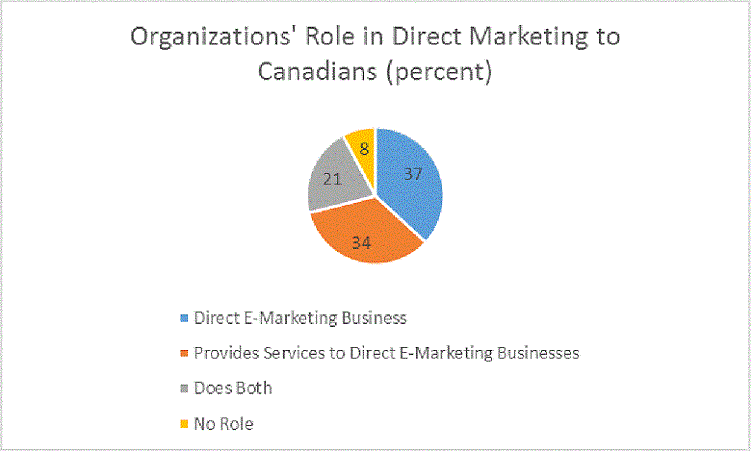
The proportion of revenues directly
originating from direct e-marketing to
consumers and other businesses for those
respondents that had revenues varied from as
little as 10% to 100%. Most of the
responding businesses sell to Canadian
consumers and businesses.
Two thirds of the
businesses that send CEMs to Canadians
reported that they had lists consisting of
both express and implied consent based
lists.
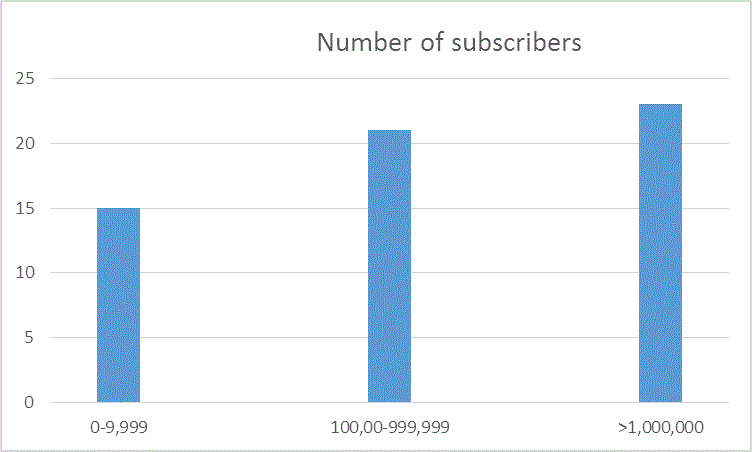
The respondents (measured by the number of
subscribers) were evenly distributed (Chart
2).
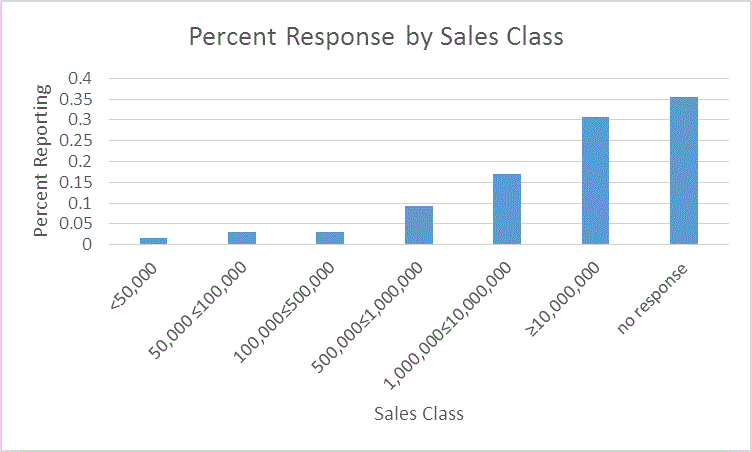
Nearly one half of
the respondents reported sales greater than
$1,000,000 with 30% having sales greater
than $10,000,000 (Chart 3). This may be
indicative of a capacity to adapt and/or
adjust to changes in the regulatory regime.
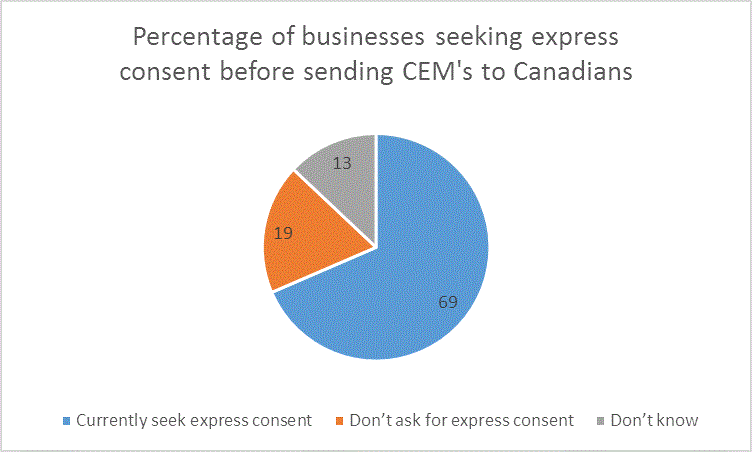
More than two thirds
of the responding businesses ask for express
consent (Chart 4). This suggests that the
businesses are well positioned for changes
in the consent regime in the summer of 2017.
Of the companies that
contact Canadian consumers, 50% of the
contacts are associated with express
consent. Nearly 50% of the companies
reported that their contacts with Canadians
were 100% express consent based.
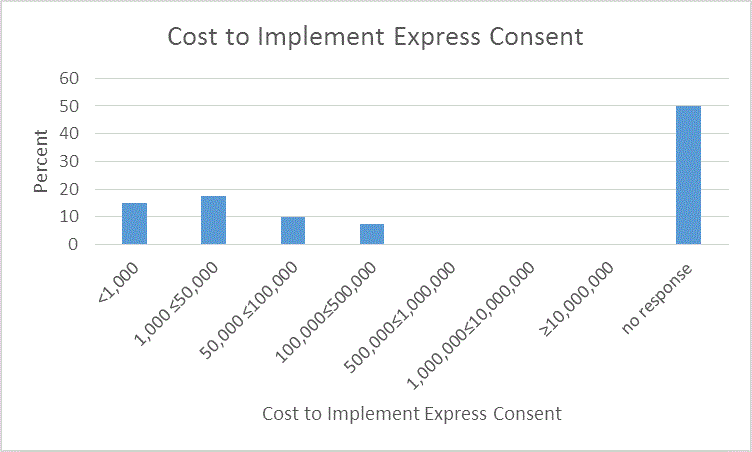
With respect to Chart
5, of those respondents who estimated costs
associated with converting to an express
consent based CEM model, all but three
reported conversion costs less than
$100,000, but 50% of the respondents
indicated that compliance costs were
unknown. It is important to note that the
response to this question was the weakest in
the survey and it is not obvious that this survey
question was addressed by those individuals
in the responding companies best equipped to
respond. Still, the response to this
question suggests that compliance costs to
the respondent may not be a significant
deterrent to conforming to new requirements
for consent.
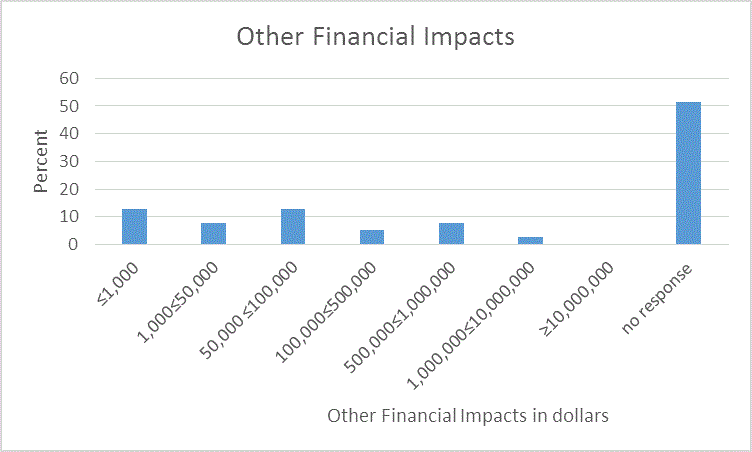
With respect to Chart
6, other financial costs were reported in a
manner similar to that of question 11 in the
survey. The weakness in the response to
this question may be attributable to the
vagueness and wording of the survey
question.
Enforcement
Action
As of February, 2016
the CRTC had received over 500,000
complaints. More than 94% of complaints
dealt with the issue of consent. Those include both the initial consent and unsubscribe requests. In response, the CRTC
has issued a number of formal Notices of
Violation and Undertakings (a kind of
settlement agreement). The CRTC reports
that it has also been creating supplementary
tools including warnings, citations and
advisories. Some of the compliance issues
identified by CRTC include insufficient
proof of consent and inadequate records to
justify reliance on implied consent and
misguided attempts to blame non-compliance
on service providers. A not uncommon
problem has been that organizations have
been poorly organized to respond in a timely
way to an unsubscribe request.
Since CASL came into
force CRTC enforcement actions included:
-
Compu-Finder was
issued the first Notice of Violation
under CASL. This meant a $1.1 million
administrative monetary penalty for
sending CEMs without consent and then
offering what amounted to an ineffective
mechanism to unsubscribe.
-
PlentyofFish
Media provided an undertaking and paid a
$48,000 administrative penalty for an
alleged failure to offer customers a
clear and effective unsubscribe
mechanism.
-
Porter Airlines provided an
undertaking and paid a $150,000
administrative penalty allegedly for
failing to prove consent
for CEMs, for transmitting inadequate
CEMs and failing to use an appropriate
unsubscribe option.
-
Rogers Media Inc.
entered into an undertaking and paid an
administrative penalty of $200,000 for
allegedly offering an inadequate
unsubscribe mechanism and lack of
timeliness in responding to unsubscribe
requests.
-
Avis Budget Group
Inc. (and its car rental companies
Aviscar and Budgetcar) was the subject
of proceedings initiated by the
Competition Bureau under CASL seeking
$30 million in administrative penalties
and compensation to customers for
allegedly deceptive marketing of vehicle
rental rates in CEMs.
The future
There is some
indication that while larger direct
marketing corporations have made the
transition to an express consent model,
smaller businesses are not yet fully
compliant with CASL requirements. This may
be attributed to inadequate record systems
to enable those businesses to rely on
implied consent, lack of capacity or systems
to move from implied consent to express
consent or lack of awareness of the
technical requirements of CASL in order to
have a compliant consent. It remains to be
seen what will be the impact of the recent
enforcement actions undertaken by CRTC and
the relatively large administrative
penalties on those smaller direct mailing
businesses and their compliance efforts.
For more information
about CASL see the CRTC website at
http://crtc.gc.ca/eng/casl-lcap.htm.
Gary Dickson
|